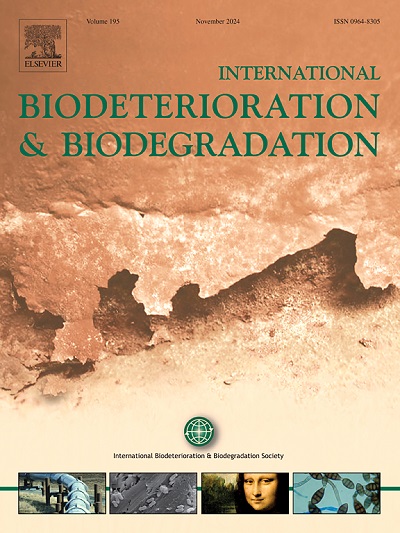壳聚糖/TiO2/ZnO三元复合醇酸纳米涂料的海洋防生物污配方研究
IF 4.1
2区 环境科学与生态学
Q2 BIOTECHNOLOGY & APPLIED MICROBIOLOGY
International Biodeterioration & Biodegradation
Pub Date : 2025-06-09
DOI:10.1016/j.ibiod.2025.106136
引用次数: 0
摘要
海洋生物污染是对海洋船舶和结构的性能和耐久性的重大挑战。研究了壳聚糖/TiO2/ZnO纳米复合醇酸纳米涂层的制备方法。从虾壳中有效提取壳聚糖,合成了原始的ZnO和TiO2纳米颗粒,形成二元和三元纳米复合材料。用各种分析技术对所得材料进行了表征。紫外-可见光谱证实了三元复合材料在原始TiO2和ZnO界面处的吸收边发生了位移。x射线衍射和高分辨率透射电镜证实纤锌矿ZnO为六方纳米棒,而TiO2为锐钛矿相,形貌为球形。拉曼光谱和x射线光电子能谱证实了复合材料中存在原始的TiO2和ZnO纳米颗粒。壳聚糖/TiO2/ZnO复合材料在50 μg/mL浓度下具有较强的抗菌和抗生物膜活性。此外,将这些纳米复合材料掺入到醇酸树脂基纳米涂料中,并涂覆在低碳钢板上。通过热重分析,确定了TiO2和ZnO在760℃时的残留量为32.49%。水接触角测试表明,三元复合材料的疏水性为90.17°。介观实验和现场暴露试验表明,壳聚糖/TiO2/ZnO涂层表面的微污染和大污染显著减少。值得注意的是,浸泡在海水中45天的藤条附着数在壳聚糖/TiO2/ZnO涂料上的粘附率为10%。现场浸渍研究结果表明,该纳米涂料作为一种有效的海洋防污材料具有巨大的潜力。本文章由计算机程序翻译,如有差异,请以英文原文为准。

Formulations of chitosan/TiO2/ZnO ternary nanocomposites-based alkyd nanopaint for marine anti-biofouling application
Marine biofouling is a significant challenge for the performance and durability of marine vessels and structures. This study focuses on developing a chitosan/TiO2/ZnO nanocomposite-based alkyd nanocoating to mitigate biofouling. Chitosan was effectively extracted from shrimp shell, pristine ZnO and TiO2 nanoparticles were synthesized to form binary and ternary nanocomposites. The resultant materials were characterized using various analytical techniques. UV–Visible spectroscopy confirmed that the ternary nanocomposites exhibited a shift in the absorption edge at the interface between pristine TiO2 and ZnO. X-ray diffraction and High-Resolution Transmission Electron Microscope confirmed wurtzite ZnO as hexagonal nano rods and anatase-phase TiO2 with a spherical morphology. Raman and X-ray photoelectron spectroscopy confirmed the presence of pristine TiO2 and ZnO nanoparticles in the composites. The chitosan/TiO2/ZnO composite materials were evaluated at a concentration of 50 μg/mL and demonstrated enhanced antibacterial and antibiofilm activities. In addition, alkyd resin-based nanopaints were formulated by incorporating these nanocomposites and coated onto mild steel coupons. The residue weight of TiO2 and ZnO (32.49 % in 760 °C) in the formulation was confirmed by thermogravimetric analysis. The water contact angle measurement indicated a hydrophobicity of 90.17° for the ternary composite. Mesocosm experiments and field exposure trials showed a notable reduction in microfouling and macrofouling on surfaces coated with chitosan/TiO2/ZnO paint. Notably, the barnacle attachment count on coupons submerged in seawater for 45 days showed 10 % adherence on the chitosan/TiO2/ZnO paint. The results of the field immersion study indicate that this nanopaint exhibits significant potential as an effective material for marine antifouling applications.
求助全文
通过发布文献求助,成功后即可免费获取论文全文。
去求助
来源期刊
CiteScore
9.60
自引率
10.40%
发文量
107
审稿时长
21 days
期刊介绍:
International Biodeterioration and Biodegradation publishes original research papers and reviews on the biological causes of deterioration or degradation.

 求助内容:
求助内容: 应助结果提醒方式:
应助结果提醒方式:


